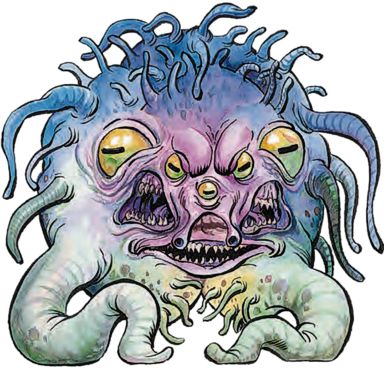

Monstrous Manual

| Feyr | Great Feyr | |
|---|---|---|
| Freyeur | Grande freyeur | |
| Climate/Terrain: | Urban | Any |
| Frequency: | Very rare | Very rare |
| Organization: | Loose band | Solitary |
| Activity Cycle: | Night | Any |
| Diet: | Emotions | Emotions |
| Intelligence: | Low (5) | High (14) |
| Treasure: | Nil | Nil |
| Alignment: | Chaotic evil | Chaotic evil |
| No. Appearing: | 1-4 | 1 |
| Armor Class: | 2 | -2 |
| Movement: | 12 | 12, Fl 18 (B) |
| Hit Dice: | 4 | 16 |
| THAC0: | 17 | 5 |
| No. of Attacks: | 1 | 1-4 |
| Damage/Attack: | 1-4 | 2-12/2-12/2-12/2-12 |
| Special Attacks: | Fear | Emotion control |
| Special Defenses: | Nil | Invisibility |
| Magic Resistance: | 10% | 40% |
| Size: | S (2’ tall) | M (7’ tall) |
| Morale: | Fanatic (18) | Fanatic (18) |
| XP Value: | 975 | 13,000 |
Feyrs (pronounced “fears”) are created from the remnants of ordinary nightmares, mixed with residual magical energies, and unknowingly brought to life by the strong emotions of a large group of people. They are most commonly found in large cities that have a good number of mages, priests, and other spell-casters. Normal feyrs stalk the streets at night, seeking nothing more than to create havoc. Great feyrs, on the other hand, are the combination of lesser feyrs, and may be found anywhere, though they a much rarer than the common feyrs.
Common feyrs appear as humped, hunchbacked creatures, grim and inhuman in appearance. Their hide is mottled and warped like the surface of the human brain. The creature is supported by two main tentacles which act as legs, and by a handful of other tentacled limbs. Massive horizontal jaws line its underside, and the forepart of the beast has 1-5 eyes, usually the color of melted gold. The feyr’s hide is a sickly rainbow of shades, like light reflected off an oil slick. There are dull blues and blacks along the body, pale reds and magentas toward the head, and deathly greens and yellows along the belly.
Combat: The horizontal jaws of the feyr slung beneath its belly are the creature’s prime form of attack, inflicting 1d4 points of damage for common feyrs, 2d6 points for great feyrs. The feyr does not use its jaws to eat, but rather to strike terror into the hearts of those who witness its savage and bloody attacks. Those who witness the attack of either type of feyr must make a successful saving throw vs. spells or be consumed by fear (as the spell of the same name). This fear acts for 1d4 rounds for common feyrs, and 2d6 rounds for great feyrs. This form of fear only applies when the creature attacks. Merely sighting a common feyr does not inspire fear.
The great feyr has an additional power that can affect the emotions similar to the 4th-level wizard spell emotion. The range of this attack is 100 yards, may affect a 20-foot by 20-foot area, and the intended victim must make a successful saving throw vs. spells at -2 or be affected. Only the negative emotions of fear, hate, hopelessness, and sadness may be cast by the great feyr. The great feyr may cast this spell and retain its invisibility.
Common feyrs are slain by direct sunlight, though they have no fear of it themselves, and do not seek shelter with the coming sun, nor hesitate to venture out if they are still alive after sun-up. Common feyrs can use a saving throw vs. spells against sunlight created by magic spells, such as continual light, in addition to their standard magic resistance. Greater feyrs are unaffected by sunlight.
Habitat/Society: Individual common feyrs are slain by the morning light. There are occasions when several common feyrs combine to form a great feyr, which, in addition to being immune to the effects of the sun, is much more intelligent. The greater feyr seeks to inspire even stronger emotions, which it may then use to stay alive. While common feyrs do not travel far from their point of origin, great feyrs may undertake long trips, lured by strong emotional states.
While a common feyr merely slouches through the evening shadows and fogs, looking for a collection of victims to terrorize and thereby enrich itself on their emotions, a great feyr chooses to attack while invisible, playing the emotions of others, heightening emotional states already present, and driving mortal beings mad with terror and fear. While the great feyr is not banished by daylight, it prefers to work at night, and seeks to retreat into a hidden lair during daylight hours, preferably some abandoned area such as an old house, cavern, or underground structure.
Ecology: Common feyrs are created by the emotions of large masses of people, and great feyrs by compilations of lesser feyrs. The raw materials for such creatures may be found in any urban settlement, and when there is additional tension in the air, the feyrs stalk at night. Cities under siege, towns divided by rivalries or civil wars, oppressed peoples, and settlements baking under a merciless summer heat are all possible breeding grounds of feyrs. Guard and watch units are usually more than sufficient to handle the common feyrs, as those feyrs attack anything that moves. But the more dangerous great feyrs must be dealt with by a wizard or similar high-level individual, who can both withstand the attack of the feyr and dispatch it.
